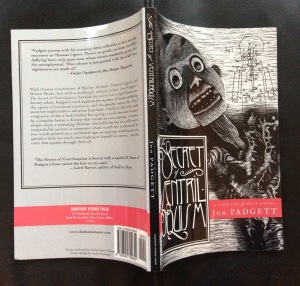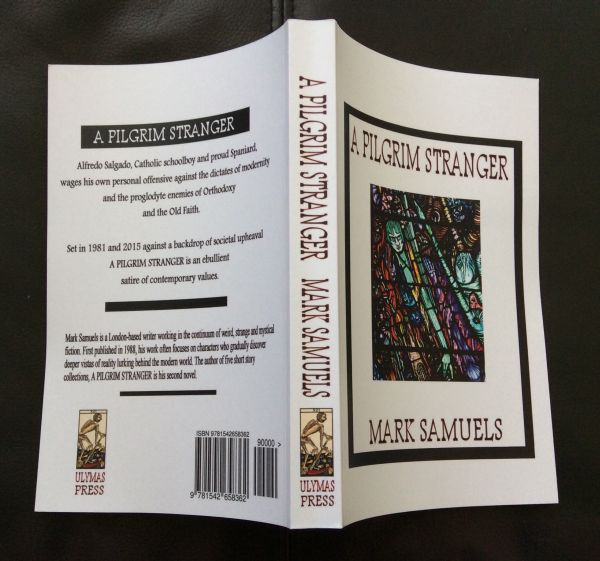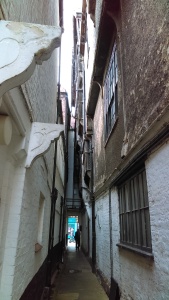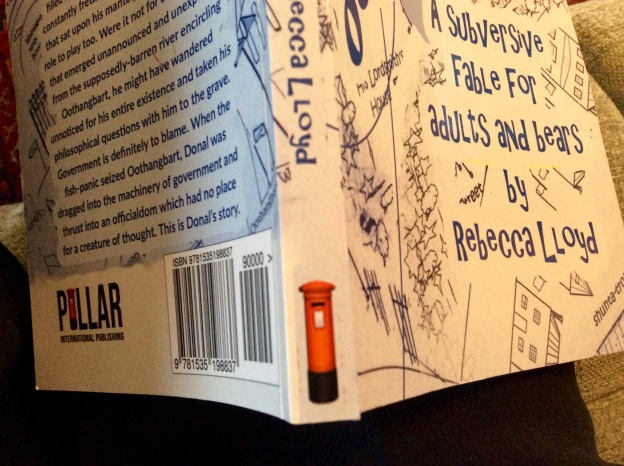The Secret of Ventriloquism – Jon Padgett

.
DUNHAMS MANOR PRESS 2016
When I real-time review this collection, my comments will appear in the thought stream below…..

www.nemonymous.com
Des Lewis - GESTALT REAL-TIME BOOK REVIEWS
A FEARLESS FAITH IN FICTION — THE PASSION OF THE READING MOMENT CRYSTALLISED — Empirical literary critiques from 2008 as based on purchased books.


 1 Forever Is A Curious Idea
1 Forever Is A Curious Idea 15 A COLUMN OF BAGELS
15 A COLUMN OF BAGELS

“Closing your eyes.”
In all seriousness, this could be the most terrifying couple and a bit of text pages you will ever read, especially if you follow through in your imagination with the synaesthetic instructions given to self-examine your own body and mind.
If I do not return to continue reviewing the rest of this book, you will know that the second time I read it (as I intend to do) that I employed something beyond mere imagination.
MURMURS OF A VOICE FOREKNOWN
“‘Now, big-head-little-body,’ my brother whispered.”
I was pleased to see that the narrator boy was – and probably still is – one of the Big-Headed People.
This is a powerful tale of this small boy being lethally taunted by his elder brother with all manner of imaginary enemies morphed perhaps from the latter’s archetypal ‘imaginary friends’ that we all had when small. Not imaginary so much as real, and in tune with the rigorously self-imagined first story that I have not yet read again, with imagination taking on a ritual hardening of truth, as the narrator himself ‘imagines’, layer by layer, layers of self and layers of space and containment above him as with an ice-pick he lurks beneath his cruel elder brother’s bed…
This narrator’s entrapment of insects in jars and his own ‘big-head-little-body’ symbiosis with a daddy-long-legs are images that will haunt you, I am sure. I can only do justice here to how these insects work accretively into the machinations of eventual revenge by telling you that I can here do no justice to these events at all.
I have heard a lot about this book before reading it, but I sense it already knows more about me than I will ever do about it.
“Its structure folds and rearranges itself like an origami figure.”
A weird journey, unlike no other, an indoor swamp as if it is the book’s own indoor and previously hidden swamp. Like a foreign channel for a voice from within your body? And the reading mind folds and arranges itself, too, whenever engaged with this book, consciously or not, a personal rollercoaster provided with an inbuilt aide mémoire of instructions to self. And it also explains my felt need to re-read it as I expressed earlier above without realising I was meant to feel this, because in this Indoor Swamp trip it now says –
“But you won’t be able to resist a return trip.”
(I intend to resist re-reading any stories in this book that I might already have read in their original publications (there are at least two of them I can see) until I can re-read the whole book as a ‘return trip’ within a re-reading gestalt.)
At the beginning of this work there is a quote from Leo Tolstoy, but I choose a different one (excuse the length), a quote from Anna Karenina, because I think the ‘scythe’ gives some clue as to the sixth finger that later vanishes….as well as the sense of involuntary ritually rhythmic dream-unconsciousness interspersed with dream-consciousness…
“And immediately after this came the delicious, slow saunter, with his hand on the scythe, during which he could wipe away the streaming sweat, take deep breaths of air, and look about at the long string of mowers and at what was happening around in the forest and the country.
The longer Levin mowed, the oftener he felt the moments of unconsciousness in which it seemed not his hands that swung the scythe, but the scythe mowing of itself, a body full of life and consciousness of its own, and as though by magic, without thinking of it, the work turned out regular and well-finished of itself. These were the most blissful moments.
It was only hard work when he had to break off the motion, which had become unconscious, and to think; when he had to mow round a hillock or a tuft of sorrel. The old man did this easily. When a hillock came he changed his action, and at one time with the heel, and at another with the tip of his scythe, clipped the hillock round both sides with short strokes. And while he did this he kept looking about and watching what came into his view: at one moment he picked a wild berry and ate it or offered it to Levin, then he flung away a twig with the blade of the scythe, then he looked at a quail’s nest, from which the bird flew just under the scythe, or caught a snake that crossed his path, and lifting it on the scythe as though on a fork showed it to Levin and threw it away.
For both Levin and the young peasant behind him, such changes of position were difficult. Both of them, repeating over and over again the same strained movement, were in a perfect frenzy of toil, and were incapable of shifting their position and at the same time watching what was before them.
Levin did not notice how time was passing. If he had been asked how long he had been working he would have said half an hour—and it was getting on for dinner-time.”
Sometimes I can imagine a ventriloquist’s dummy with that sense of easy rhythmic manipulation from within – and without. Keeping my powder dry on this.
And there is also a quote from Shirley Jackson, part of which is –
“Everything that makes the world like it is now will be gone. We’ll have new rules and new ways of living.”
Which rings true in our new world consciousness in 2017 that has ensued since this story was written, I guess.
This Padgett story is a story I would have hoped to have read earlier in my life, one that conveys perfectly – with naive simplicity and uncomplicated self-consciousness and via a traditional device of a story found as a document within the story – the onset of a family man’s reality morphing suddenly and then somehow gradually out of kilter, including the intermittent poignancy of not being able to find his wife and/or children.
There are echoes of the ‘box-screen’ that the young boy earlier penetrated with his ice-pick and of the ‘greenhouse’ into which we are now viewing the Indoor Swamp rather than looking FROM that swamp – and, again, of origami here as an intensely haunting razor-sharp stick figure as representative of the vague glitches in an otherwise familiar home. And a ventriloquist dummy and other running objective-correlatives.
And a preternatural hint, I suggest, of Kroth-Kroll, Dunnstown-Dunhams?
I found this story dream-disarming, which is a whole lot more than just one finger! A tale of ‘peripheral vision’…as is this review of it, in emulation.
“broken images and hollow grief.”
Ligottian? “The children becoming even stranger to me.”
“There had also been an unusual, real-time consistency to the events so far, without the sudden leaps from one scene to the next so typical in dreams.”
(In 1986, my first published story’s title was “Padgett Weggs.”)
—————————————-
20 Simple Steps To Ventriloquism by Jon Padgett
“Of course, you may think this is all complete nonsense to say, but a lot of things that people say – even most things – are complete nonsense. This is not the ventriloquist’s concern.”
This is a rule book that starts accretively building up sense, not nonsense, regarding the art of ventriloquism, and I am confident that I can reach a certain level and be an acceptable ventriloquist as a result of practising the first few stages. In 1950s UK when I was a boy, there was a very successful ventriloquist on the wireless by the name of Peter Brough with a dummy called Archie Andrews, neither of whom, of course, we could see. There is something sinister about that, and when I eventually saw them much later on black and white TV, I was amazed what a bad ventriloquist Peter Brough happened to be, but having listened to them most of my then short life, there seemed a reality to Archie the dummy which outdid the reality of Brough. Like Miss Rosalyn, later on Romper Room, whom I mentioned earlier in this review in connection with ‘Wishing Well’ by Cody Goodfellow — she brought me to life by looking through the grainy screen that TV Screens tended to be all those years ago and saying that she could see me, scrying me into existence. And this story brilliantly captures that process by a manner of artful means, and is probably one of the most frightening stories you are likely to read if you read it properly because, as in all reading of fiction, and like these very reviews I have been doing since 2008, there is an element of my manipulating the story so that it can manipulate me. You need to work with stories so that they can work with you, working them working you, feeling their tendrils come out of the words and tug your levers and pulleys with prepared ligatures or deceptively tied ligotti. As in the Morris story, ‘the play is the Theatre’. Test out Gardner’s Yellow Bird Strings, too. This Padgett story, if it isn’t already, should become a classic that will be anthologised several times in the future.
——————————–
A real-time review by Des Lewis
THE INFUSORIUM by Jon Padgett
Dunhams Manor Press 2015
I have just received this book as purchased from the publisher.
My previous review of a Jon Padgett work HERE.
I intend to review this work in the thought stream found below or by clicking the post’s title above.
*
Pages 7 – 18
“Why did I bother connecting the dots between those missing persons and the skeleton letters?”
A satisfyingly prose-clotted Dunnstown urban noir feel, where the feisty and eye-catching and asthmatic woman detective narrator crudely (yet with a good texture) soliloquises us as if we readers are really here or there, paying attention to her, our eyes agog, lungs primed, to hear all what she tells us about her police career and her partnership with Detective Guidry, and the librarian who, with her researching at his library the ‘appendages’ skeleton case, comes up on her gaydar, I guess — and, meanwhile, the skeletons case itself (weird Tree of Life and its bony roots?) and the city blending into parkland without any markers indicating where the cusp between them becomes one or the other, and the still smoky, crap-foggy residues of a derelict Paper Mill in Treasure Forest, are somehow interrelated, all striking me as pretty suffocating but also enchanting (paradoxically). Enthralling. Must eke it out and savour its soot slowly. Another 20 pages yet to read and report on here. No spoilers, though.
The previous fiction by this author I’ve read and enjoyed is about ventriloquism. No ventriloquism here – so far. But vents? Maybe. Just maybe.
*
Pages 18 – 28
“Once at a railway crossing, I was nearly hit by a muted locomotive engine puffing down the tracks, winding its way through the fog-diseased park neighborhoods — the train appearing and disappearing like a ghost of itself.”
My first published story was entitled ‘Padgett Weggs’ in 1986 when I was 38. Just thought I’d mention that gratuitously.
I am increasingly impressed by the cut of this text’s jib. The narrator and Guidry visiting the Paper Mill, where there floats either flakes of asbestos or Sea Monkeys (please see their wonderful dialogue about the latter – not to be missed) both of which phenomena I sense to be insidiously parthenogenetic. (Parthenogenesis – along with the Large Hadron Collider at CERN Zoo – was in the UK news today, as scientists have discovered endangered species somewhere fighting against extinction with this method). The narrator’s later visit to the librarian (the reading about which I am at present tantalisingly ‘in media res’) is mordantly funny and the characterisation is believably developing in various directions of scatological and eschatological personal eccentricity, as is the Dunnstown ambiance and the mystery of the skeleton creatures (I can’t do justice here to what they are like – you need to read the book for that.)
Preternaturally, I still seem to have the knack of choosing books to read that have that same preternatural power, judging by the evidence of this book – so far.
This is Ligottian Corporate Horror to a new and still awakening degree of dark parthenogenesis (with the help of Padgett and various oxygen masks).
*
Some more Camille Gabrielle that first appeared in ‘The Weirdmonger’s Tales’ in 1994, the third one of which at least seems, with some serendipity, to resonate preternaturally with this book:
*
Pages 28 – 38
“I’m honestly not sure even now if the content of those letters came before or after the event itself began.”
The ‘genesis of a nervous condition’, it seems, those anonymous letters. You see, I once published a series of multi-authored anthologies called ‘Nemonymous’ that had only anonymous fictions, and I called it ‘parthenogenetic literature’ on their front covers. And now I am gratified that I may have found today – with this novelette by someone called Padgett – the apotheosis of that form of literature, even though the author himself may be scratching his own head when seeing this claim of mine. This book now reaches some form of ‘Function Room’, and in this case it is where the Paper Mills create the paper that create the characters upon their surfaces: then float off as flakes like asbestos, and the whole horror skeleton thing with its bone-misconfigurations desiccated by or into oxygen ghosts that emerge along with Sea Monkeys, like clowns, like sharks, into the Black Fog of communal anti-natalisms via the ‘madness’ of the narrator. Now doubled up by one of the reviewers of the book (me), adding madness to madness. Which the vent, which the dummy? A book evolving retrocausally on this very day today when CERN restarted at a speed it has never gone before, with each reader’s madness adding to it. Then the increased madness doubling that of the reader’s madness and so on, back and forth. I feel it as I write this about it. Till some culmination, some still centre, where truth emerges? Another Function Room existed before, a completely different one, and I reviewed it here and allowed its madness to increase mine so that I could increase its own madness. I recommend it to anyone who ‘enjoyed’ this Padgett book. Meanwhile, if you want the real plot, read the book. I have the librarian’s “unwanted enthusiasm”, perhaps (page 27).
“Snap. The skeleton-dummy’s mouth shut and opened again.”
“A chorus of beeping and engine gunning echoes across the cyclopean overpass-wasteland, the single eyes of the daddy-longlegs street lights glaring down.”
The opening is like the opening of the film LA LA LAND, with the leading woman’s car on the Interstate, except here the dancers are the homeless and the music Ligottian. The imagined singing, as I call it, punctuated with sounds of diarrhoea. A powerful nine page prose poem, one symbolising the handwritten Organism is the Nightmare placard, here another sign saying ORGAN –VOID, with all the possible meanings of the word ‘void’ as a gestalt and the Doctor come to cure you has a name as that sign’s anagram, if anyone noticed!
This is INDOOR SWAMP made bodily human. With more daddy-long legs than ever before punctuating any book.
And on the underpass, looking up, like being under the bed earlier.
A Play in 1 Act
“Passengers were disappearing from the airport –”
“You’re like a fucking toddler — not a man.”
“I had been so confident — so cocksure — that I knew how to work my lady friend inside and out like the dummy she was (and is).”
Including her “sexy tush”, it seems!
As far as I can tell, this work was first published in 2015, and it must be seen to come up even fresher today!
An Alfred Jarry type drama for our modern times and sharing the intrinsic unforgettability of the “20 Simple Steps” work earlier in this book, feeding off it and retrocausally feeding back into it, too.
It certainly accentuates the hand manoeuvres of today, the toddlership of mankind, recently revealed by similar hand manoeuvres of small hands and the workability of the strange opening and shutting mouth by synchronised manipulation as well as cause and effect from a hierarchy of ventriloquists.
I can imagine reading this book again and again in order to transcend its sheer horror but –
“…if you tried to apply the steps to come hundreds, thousands or even millions of times, I’m afraid you would ultimately meet with failure.”
Whether you be doll or dummy.
Indoor swamps, notwithstanding.
There are also strange views of a bed in this obliquely but strikingly prophetic play to match those earlier.
“…taking its first baby steps — slatted mouth open…”
Bathmophobia, notwithstanding.
“…like jumping off the interstate overpass and finding yourself on the top of a mountain.”
Little Evie’s songs for La La Land again? Or, indeed, as the story itself implies, Mary Poppins.
This is the book gestalt’s clinching coda and if any book deserves a gestalt real-time review this one does. You will know exactly what I mean when you read the book.
This coda itself is rhapsodic, with a dark underpass we all fear, a prose poem supreme in around seven textured pages.
“Little Evie’s song — like the one she’s singing now — was all made up, spur of the moment like, never to return or be duplicated, melting away…”
That makes me do the steps of a ‘herky-jerky jig’, secret hand in my back.
But LIttle Evie can be kind, as well as mean.
“…special knickknacks that Little Evie found for us once in a dumpster outside of the Indoor Swamp.”
And when you do reopen the book you will find “Little Evie is singing again.”
I hope that is not a spoiler.
A thin mountain with its big head become dangling daddy longlegs shaped into words.
end